Choose the Right Size Rug for Your Dining Room
When it comes to decorating your dining room, choosing the right size rug can make all the difference. A properly sized rug can tie the room together and add warmth and comfort to your space. However, selecting the right size rug for your dining room table can be tricky. Too small and it can make the room look disjointed, too big and it can overpower the space.
To choose the right size rug for your dining room table, start by measuring the dimensions of your table. The rug should be large enough to accommodate the table and chairs, with at least 24 inches of space on all sides to allow for comfortable movement. Keep in mind that the shape of your table can also play a role in selecting the right rug size. A rectangular table may require a rectangular or oval-shaped rug, while a round table may call for a circular rug.
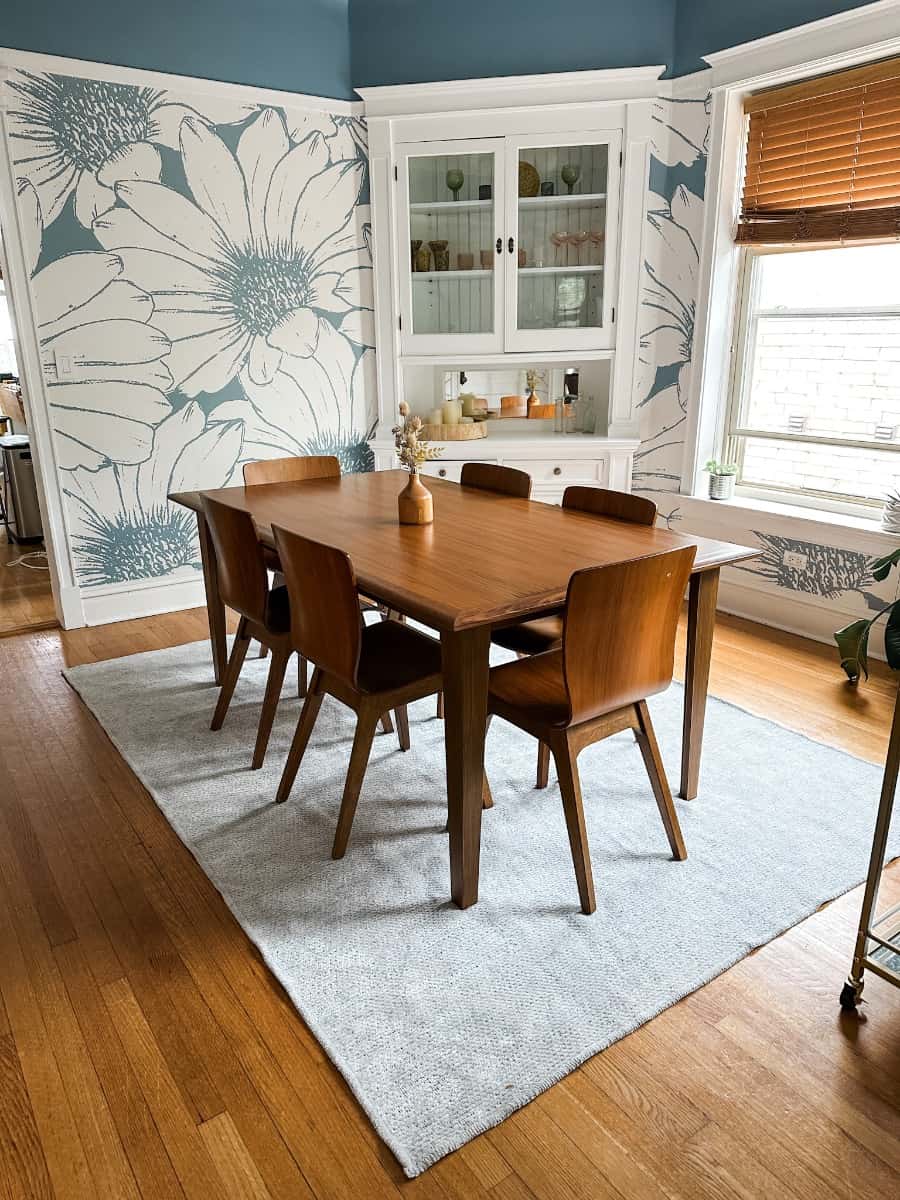
Consider the overall style and design of your dining room when selecting a rug. A bold, patterned rug can add visual interest to a room with neutral walls and furniture, while a solid-colored rug can provide a more subtle, cohesive look. With these factors in mind, you can confidently choose the right size rug for your dining room table and create a space that is both functional and stylish.
On my blog Living Large in A Small House, I may sometimes use affiliate links, which means a small commission is earned if you make a purchase via the link. The price will be the same whether you use the affiliate link or go directly to the vendor’s website using a non-affiliate link. You can find my full Disclosure Policy HERE
Understanding Rug Sizes
Choosing the right size rug for your dining room table is essential to create a cohesive and functional space. A rug that is too small will make the room look unbalanced, while a rug that is too large will dwarf the table and chairs. Here’s what you need to know about rug sizes to help you make the right choice for your dining room.
Working the Boutique Rugs to choose the perfect rug for the dining room space in both Annie’s Home in Dallas and Emma’s apartment in Chicago. I also needed a dining room rug but chose one that I already had in stock. Both the girls had rugs that didn’t work for their space and needed a new rug.
Annie has a round table and needed a rug that would not only fit under the custom table that “Handy” made for them but also be cohesive with the living room area that is part of their open-concept living space. The first rug she bought was too small for the space and the table. The rug Annie & Tommy chose was the Urja Geometric Blue Area Rug in size 7’10” Round. They love the size and the style of the rug under their round dining table in their home.
Emma has a small rug in her dining space that I had that was also too small for the space. Once we wallpapered her dining room, it was also the wrong color. The Boutique Rug we chose for Emma’s Dining Room was the Isako Light Blue Solid Washable Area Rug in size 6’7” x 9’. The size and color were the perfect choice for her dining room.

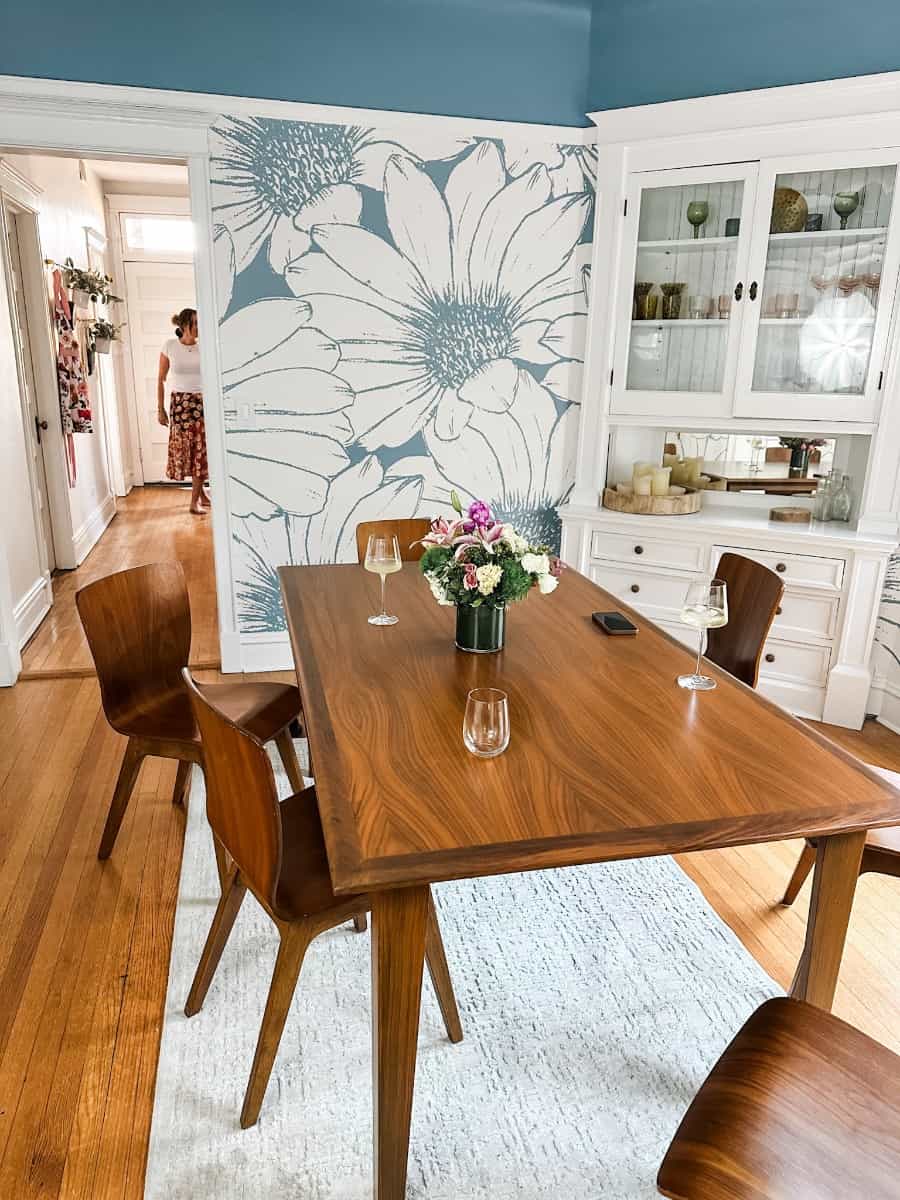



Rug Sizes
Rug sizes are usually measured in feet and inches, and they can vary depending on the manufacturer.
The most common rug sizes for dining rooms are 8×10 feet and 9×12 feet. However, you can also find rugs that are smaller or larger than these sizes. Here’s a table that shows the standard sizes and their dimensions:
| Rug Size | Dimensions |
|---|---|
| 5×7 feet | 60 inches x 84 inches |
| 6×9 feet | 72 inches x 108 inches |
| 8×10 feet | 96 inches x 120 inches |
| 9×12 feet | 108 inches x 144 inches |
| 10×14 feet | 120 inches x 168 inches |
Rug Placement
Once you have chosen the right size rug and shape of the rug for your dining room, you need to decide on the placement. Here are some tips to help you:
- The rug should be large enough to accommodate the table and chair legs, even when they are pulled out.
- The rug should extend at least 24 inches beyond the table on all sides.
- If you have a round table, choose a round rug that is at least 8 feet in diameter.
- If you have an oval table, choose a rectangular rug that is at least 2 feet wider and longer than the table.
Rug Material
Choosing the right type of rug is also important. The material of the rug is a big consideration. You want a rug that is durable and easy to clean, especially if you have children or pets. Here are some common rug materials:
- Wool: Wool rugs are durable and can last for many years. They are also soft and comfortable underfoot.
- Synthetic: Synthetic rugs are easy to clean and maintain. They are also less expensive than wool rugs.
- Natural fibers: Natural fiber rugs, such as jute and sisal, are eco-friendly and add texture to the room. However, they can be difficult to clean.
Choosing the right size rug for your dining room table can be a daunting task, but with these tips, you can make an informed decision that will enhance the look and functionality of your space.

Assessing Your Dining Room Space
When it comes to choosing the right size rug for your dining room table, it’s important to assess your dining room space. Here are a few things to consider:
Room Dimensions
The first thing you’ll want to do is measure your whole room. Measure the length and width of the room and write down the dimensions. This will help you determine what size rug you’ll need.
Keep in mind that you’ll want to leave at least 18 inches of space between the edge of the rug and the walls of the room. This will help create a balanced look and ensure that the rug doesn’t overwhelm the space.
You also don’t want your other pieces of dining room furniture to be on the rug.
Furniture Dimensions
Next, you’ll want to measure your dining room table and chairs. Measure the length and width of the table and write down the table size. Then, measure the distance between the legs of the table and chairs. This will help you determine how much space you’ll need for the correct dining room rug size.
When choosing a rug size, you’ll want to make sure that it’s large enough to accommodate the table and chairs, even when they’re pulled out. A good rule of thumb is to add 24-30 inches to the length and width of your table to determine the minimum size of rug you’ll need.
By assessing your dining room space, you’ll be able to choose the right size rug for your dining room table. Remember to take accurate measurements and leave enough space around the edges of the rug to create a balanced look.
Choosing the Right Rug Shape
When it comes to choosing the right rug for your dining room table, shape is just as important as size. Here are a few tips to help you choose the right rug shape for your dining room:
- Rectangular Rugs
- Rectangular rugs are the most common shape for dining room tables. They work well with rectangular and oval tables, and they provide plenty of space for chairs to move in and out. When choosing a rectangular rug, make sure it’s large enough to fit under your table and chairs with enough space to spare.
- Round Rugs
- Round rugs are a great option for circular or square dining tables. They create a cozy, intimate feel and can soften the hard lines of a square or rectangular room. When choosing a round rug, make sure it’s large enough to accommodate your table and chairs without feeling cramped.
- Square Rugs
- Square rugs can work well with square or round tables, but they can be a bit trickier to pull off. Make sure the rug is large enough to fit under your table and chairs with enough space to spare. If your dining room is rectangular, a square rug can help create a more balanced look.
- Oval Rugs
- Oval rugs are a great option for long, narrow dining rooms. They can help break up the hard lines of a rectangular room and create a more organic feel. When choosing an oval rug, make sure it’s large enough to fit under your table and chairs without feeling cramped.
Remember, the shape of your rug should complement the shape of your dining table and the overall style of your room. With these tips in mind, you can choose the right rug shape for your dining room with confidence.

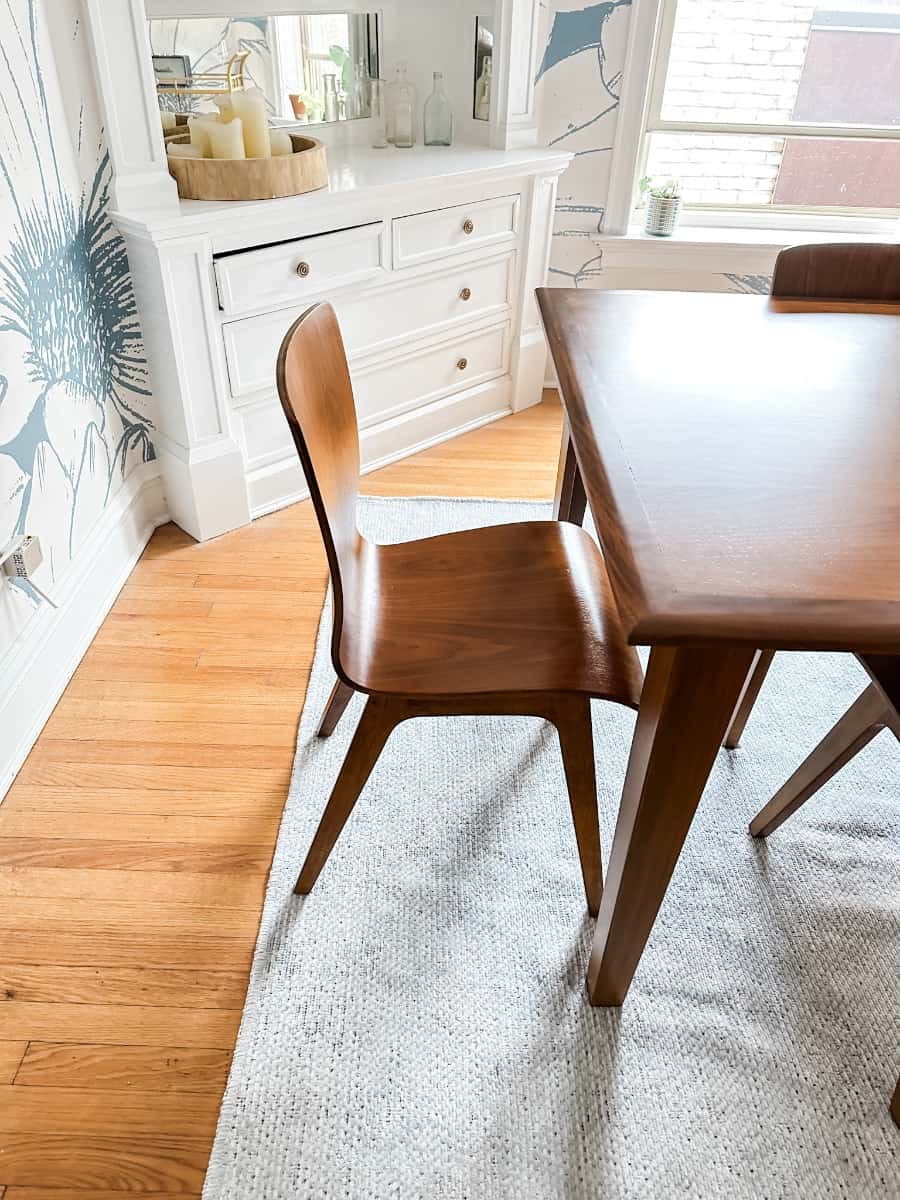
Importance of Rug Material
When choosing a rug for your dining room rug, the material you choose is just as important as the size.
Different materials have different properties that affect the durability and maintenance of the rug. Here are some things to consider when choosing the right material for your dining room rug.
Durability
Durability is an important factor to consider when choosing a rug material for your dining room. Dining rooms are high-traffic areas, so you want a rug that can withstand the wear and tear of daily use. Here are some materials that are known for their durability:
- Wool: Wool is a natural fiber that is known for its durability and resilience. It is also stain-resistant and easy to clean, making it a great choice for dining rooms.
- Polypropylene: Polypropylene is a synthetic material that is known for its durability and resistance to stains and fading. It is also easy to clean, making it a great choice for dining rooms.
- Nylon: Nylon is a synthetic material that is known for its durability and resistance to stains and fading. It is also easy to clean, making it a great choice for dining rooms.
Maintenance
Maintenance is another important factor to consider when choosing a rug material for your dining room. You want a rug that is easy to clean and maintain, so you can keep it looking great for years to come. Here are some materials that are known for their low maintenance:
- Polypropylene: Polypropylene is a synthetic material that is easy to clean and maintain. It is also resistant to stains and fading, making it a great choice for dining rooms.
- Wool: Wool is a natural fiber that is easy to clean and maintain. It is also stain-resistant, making it a great choice for dining rooms.
- Polyester: Polyester is a synthetic material that is easy to clean and maintain. It is also resistant to stains and fading, making it a great choice for dining rooms.
- Washable Rug – Emma chose a washable rug. Being single in a major metropolitan city, she entertains her friends often so a rug that can be washed is a must.
A rug pad can also enhance the life of a rug as well as keep it in place when chairs are moved in and out from under the table. In my opinion, this is a very important thing to have with any rug.
In conclusion, when choosing a rug material for your dining room, consider the durability and maintenance of the material. Wool, polypropylene, and nylon are known for their durability, while polypropylene, wool, and polyester are known for their low maintenance. Choose a material that fits your needs and lifestyle to ensure that your rug lasts for years to come.
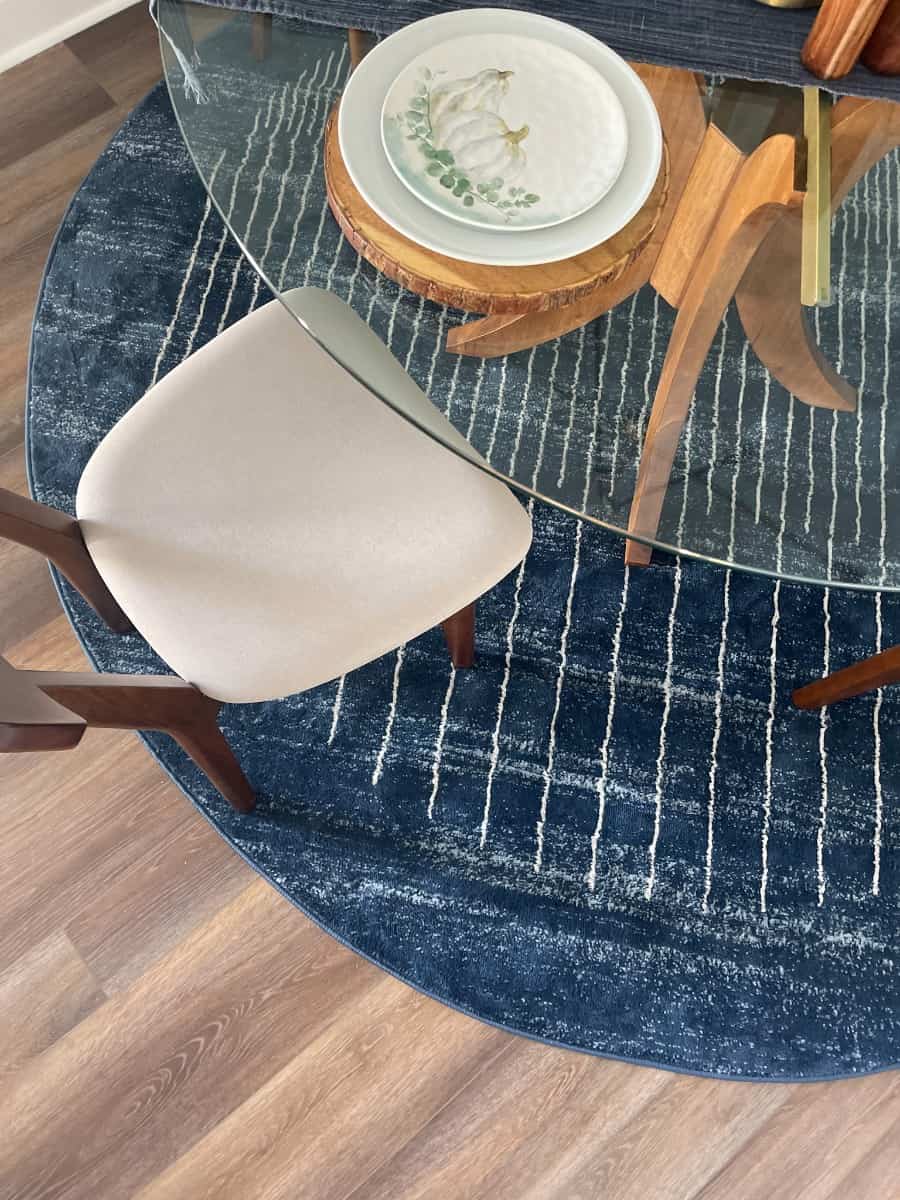

Color and Pattern Considerations
When choosing a rug for your dining room table, color and pattern are important considerations. You want to choose a rug that complements the overall color scheme and style of your dining room.
One option is to choose a rug that matches the color of your walls or curtains. This creates a cohesive look and ties the room together. Another option is to choose a rug in a complementary color. For example, if your walls are light blue, a rug in a darker shade of blue or a complementary color like orange or yellow can add interest and depth to the room.
When it comes to patterns, you want to choose a rug that doesn’t clash with the patterns already present in the room. If you have patterned curtains or wallpaper, a solid color rug may be the best choice. However, if your room is relatively neutral, a patterned rug can add texture and visual interest.
It’s also important to consider the size of the pattern. A large pattern can overwhelm a small room, while a small pattern may get lost in a larger space. If you have a small dining room, consider a rug with a small or medium-sized pattern. In a larger dining room, a rug with a larger pattern can make a statement.
Overall, when choosing a rug for your dining room table, consider the color scheme and patterns already present in the room, and choose a rug that complements them.

Balancing Aesthetics and Functionality
Choosing the right size rug for your dining room table is not just about aesthetics; it’s also about functionality. The rug should not only look good but also serve its purpose by protecting your floor and making it easier to move chairs in and out. Here are some tips on how to balance aesthetics and functionality when choosing a rug for your dining room.
Size Matters
One of the most important factors to consider when choosing a rug for your dining room is the size. The rug should be large enough to accommodate your dining table and chairs, but not so large that it overwhelms the space. Here are some general guidelines to follow:
- The rug should be at least 24 inches wider and longer than your dining table.
- Allow for at least 18 inches of rug beyond the edge of the table to accommodate chairs.
- If you have a round table, choose a round rug that is at least 8 feet in diameter.
Material Matters
The material of your rug is another important consideration. You want a rug that is durable, easy to clean, and comfortable underfoot. Here are some popular options:
- Wool: Wool is a durable and long-lasting material that is easy to clean and maintain. It is also soft and comfortable underfoot.
- Synthetic fibers: Synthetic fibers like nylon and polyester are durable and easy to clean. They are also less expensive than wool.
- Natural fibers: Natural fibers like jute and sisal are durable and eco-friendly. However, they may not be as comfortable underfoot as wool or synthetic fibers.
- Low Pile: Choosing a low pile is important for a dining room rug. It makes the chairs easier to move and it will be much easier to clean if food or drinks are spilled.
Style Matters
Finally, you want a rug that complements your dining room decor. Here are some popular styles to consider:
- Traditional: Traditional rugs feature intricate patterns and rich colors. They are perfect for formal dining rooms.
- Contemporary: Contemporary rugs feature bold colors and geometric patterns. They are perfect for modern dining rooms.
- Natural: Natural fiber rugs like jute and sisal have a neutral, earthy look that complements many different styles of decor.
In summary, when choosing a rug for your dining room, you want to balance aesthetics and functionality. Consider the size, material, and style of the rug to ensure that it not only looks good but also serves its purpose.
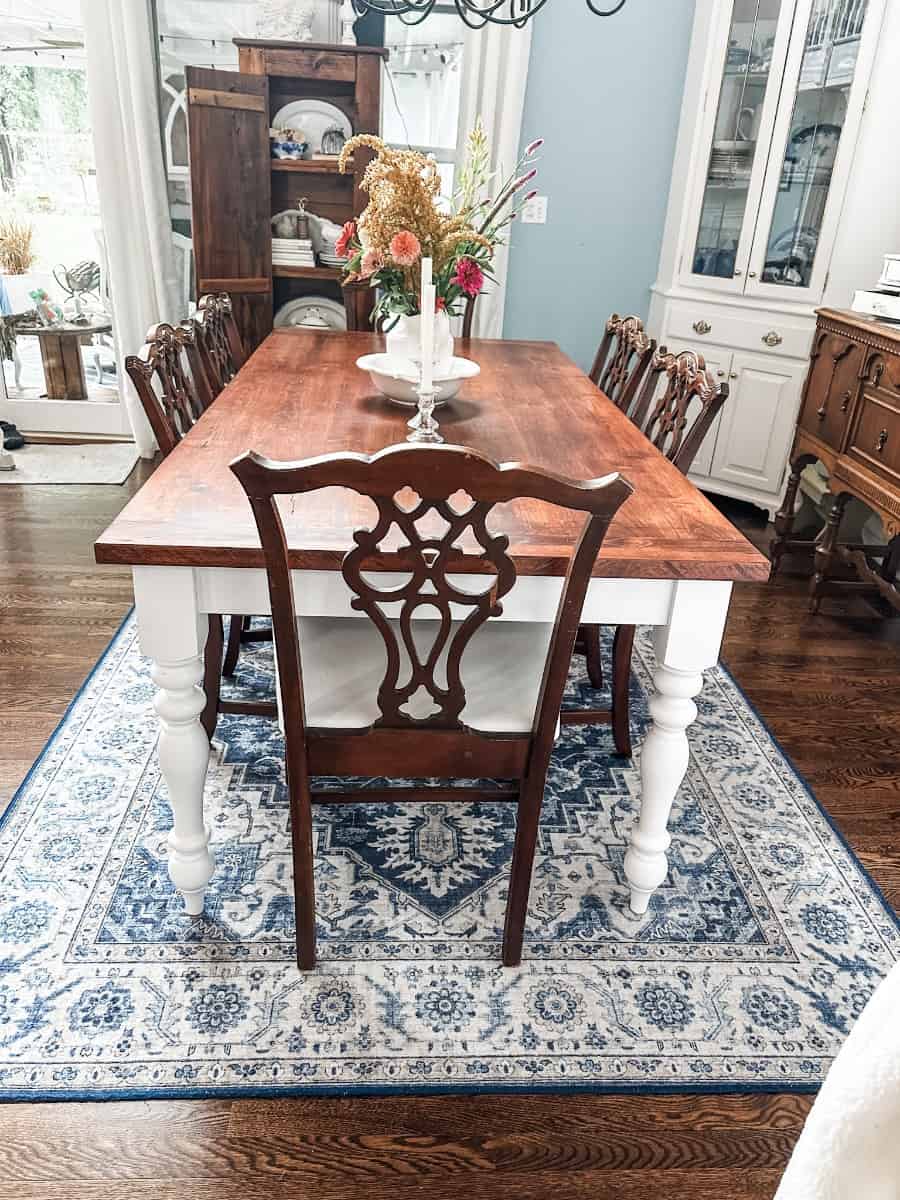
Conclusion
In summary, choosing the right size rug for your dining room table is crucial for creating a cohesive and visually appealing space. Here are a few key takeaways to keep in mind:
- The size of your rug should be determined by the size of your dining table and the surrounding space.
- A rug that is too small will make your dining area feel disjointed, while a rug that is too large can overwhelm the space.
- Consider the shape of your dining table when selecting a rug. Round tables look best with circular rugs, while rectangular tables pair well with rectangular or oval rugs.
- Keep in mind that you’ll need to leave enough space around the edges of your rug for chairs to be pulled in and out comfortably.
- When in doubt, err on the side of a larger rug rather than a smaller one.
By following these guidelines, you can ensure that your dining room is both functional and stylish.
We loved working with Boutique Rugs as their selection of sizes, materials, and styles is extensive. They also have very affordable rugs. I’ve working with Boutique rugs for my living room, my outdoor living room, my office, and for the rug on my front porch.
If you’re in need of a new, affordable rug, look no further than Boutique Rugs. You can also use my discount code: LIVINGLARGE (10% off sitewide on top of the already saled price)
Happy Rug Shopping!
Peace and Love,

Frequently Asked Questions
What are some common rug sizes for a dining room table?
The most common rug sizes for a dining room table are 8×10 feet, 9×12 feet, and 10×14 feet. These sizes allow for the rug to extend beyond the table and accommodate the dining chairs.
Should all four legs of the dining chairs be on the rug?
Ideally, all four legs of the dining chairs should be on top of the rug. This helps to keep the chairs stable and prevents them from wobbling. If the rug is too small, you can place the front legs of the chairs on the rug and the back legs off the rug.
Can a rug be too small for a dining room table?
Yes, a rug can be too small for a dining room table. If the rug is too small, it can make the room look unbalanced and the chairs may not fit comfortably on the rug. It’s important to measure your dining room table and choose a rug that is at least 2 feet larger on all sides to ensure that it fits properly.

Thanks for Following Along
If you enjoyed this post I hope you sign up to be a friend of Living Large in A Small House! Then you won’t miss any of the inspiration that is shared with you each week! You can also follow me on Instagram, Facebook, and YouTube. I share even more inspiration on Pinterest! You can listen to me chat on my Podcast.


A great way to save this article is to save it to your Pinterest boards. You can find the pin button in the top right corner of the photo below. Also, don’t forget to follow me on Pinterest




living large podcast
This week on the Podcast I talk with my friend Amy Sadler about our shared love for using essential oils in our small homes.


Featured




















What a great post Lynn, It really makes a big difference when you choose the correct size rug.
Hi Wendy –
You are so right. The proportions, style, and materials all need to be right to be a good fit for a dining room rugs.